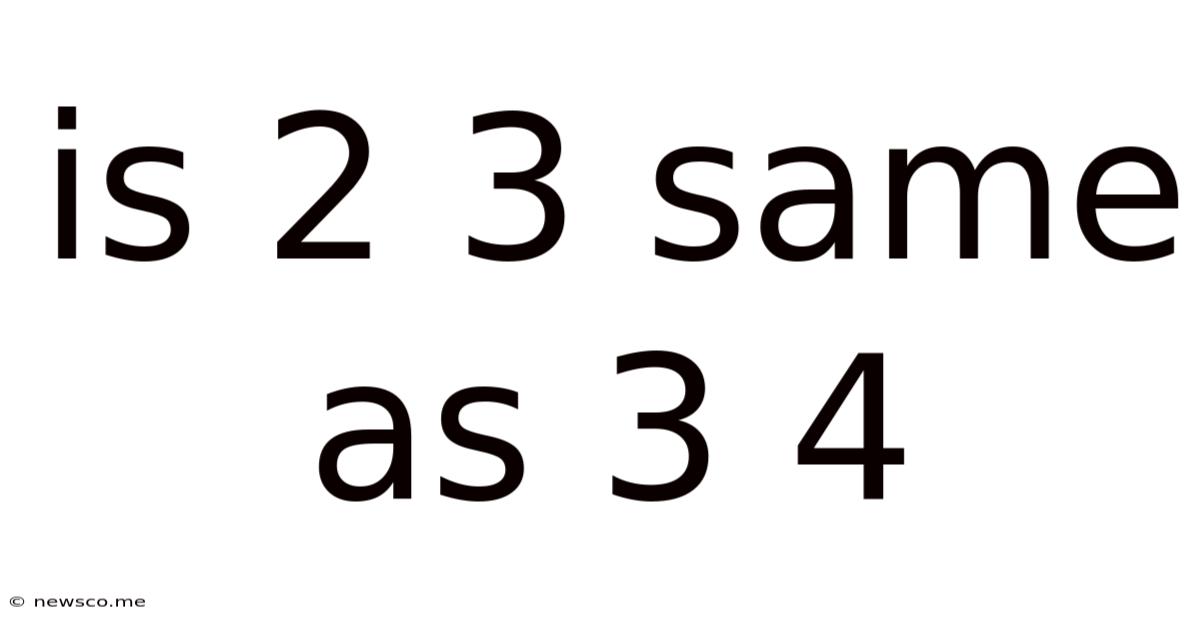Is 2 3 Same As 3 4
News Co
May 07, 2025 · 4 min read

Table of Contents
Is 2/3 the Same as 3/4? A Deep Dive into Fraction Equivalence
The question, "Is 2/3 the same as 3/4?" seems deceptively simple. A quick glance might lead some to believe they're equal, but a closer examination reveals a fundamental difference in their values. This article will explore this seemingly simple question in detail, delving into the concepts of fractions, equivalence, and the practical implications of understanding their differences. We'll also explore how to compare fractions effectively and address common misconceptions.
Understanding Fractions: The Basics
Before we compare 2/3 and 3/4, let's refresh our understanding of fractions. A fraction represents a part of a whole. It consists of two main components:
- Numerator: The top number, indicating how many parts we have.
- Denominator: The bottom number, indicating the total number of equal parts the whole is divided into.
For example, in the fraction 2/3, the numerator (2) represents the number of parts we possess, and the denominator (3) indicates the whole is divided into three equal parts.
Comparing Fractions: Different Approaches
Several methods exist for comparing fractions, each with its own advantages and disadvantages. Let's examine three common techniques:
1. Visual Representation
A simple and intuitive approach is to visualize the fractions using diagrams or models. Imagine two circles. Divide one into three equal parts and shade two of them (representing 2/3). Divide the other circle into four equal parts and shade three of them (representing 3/4). Visually comparing the shaded areas clearly demonstrates that 3/4 represents a larger portion than 2/3.
2. Finding a Common Denominator
This is a more formal mathematical approach. To compare fractions effectively, we need to express them with a common denominator – a denominator that is a multiple of both original denominators.
For 2/3 and 3/4, the least common multiple (LCM) of 3 and 4 is 12. We convert each fraction to an equivalent fraction with a denominator of 12:
- 2/3: To get a denominator of 12, we multiply both the numerator and denominator by 4: (2 x 4) / (3 x 4) = 8/12
- 3/4: To get a denominator of 12, we multiply both the numerator and denominator by 3: (3 x 3) / (4 x 3) = 9/12
Now, comparing 8/12 and 9/12, it's evident that 9/12 (3/4) is greater than 8/12 (2/3).
3. Converting to Decimals
Another effective method is to convert the fractions to their decimal equivalents. This is particularly useful when dealing with more complex fractions.
- 2/3: 2 ÷ 3 ≈ 0.6667
- 3/4: 3 ÷ 4 = 0.75
Comparing the decimal values, 0.75 (3/4) is clearly greater than 0.6667 (2/3).
Why the Difference Matters: Real-World Applications
Understanding the difference between fractions like 2/3 and 3/4 is crucial in various real-world scenarios:
- Cooking and Baking: Recipes often involve precise measurements. Using the incorrect fraction can significantly alter the outcome of a dish.
- Construction and Engineering: Accurate measurements are paramount in these fields. Using the wrong fraction could lead to structural problems or safety hazards.
- Finance: Calculating percentages, interest rates, and proportions accurately requires a solid understanding of fractions.
- Data Analysis: In statistical analysis and data interpretation, accurately representing and comparing fractions is fundamental to drawing valid conclusions.
Addressing Common Misconceptions
Several misconceptions surround fraction comparison. Let's address some of the most prevalent:
- Focusing solely on the numerators: Many mistakenly believe that because 3 is greater than 2, 3/4 is automatically larger than 2/3. This ignores the crucial role of the denominator. The denominator represents the size of the individual parts, and a larger denominator means smaller parts.
- Ignoring the need for a common denominator: Attempting to compare fractions directly without finding a common denominator can lead to inaccurate conclusions.
- Misinterpreting visual representations: While visual aids are helpful, they can be misleading if not drawn precisely to scale.
Beyond the Basics: Exploring Equivalent Fractions
While 2/3 and 3/4 are not equal, it's important to understand the concept of equivalent fractions. Equivalent fractions represent the same portion of a whole, even though they have different numerators and denominators. For example, 1/2 is equivalent to 2/4, 3/6, 4/8, and so on. All these fractions represent exactly half of the whole.
Finding equivalent fractions involves multiplying or dividing both the numerator and denominator by the same non-zero number. This ensures that the ratio between the numerator and the denominator remains constant, maintaining the value of the fraction.
Conclusion: The Importance of Precision
In conclusion, 2/3 is definitively not the same as 3/4. While seemingly minor, understanding the difference between these fractions is vital for accurate calculations and problem-solving across numerous disciplines. Mastering the techniques for comparing fractions, including finding common denominators and converting to decimals, is essential for anyone working with numerical data or requiring precision in their measurements. The ability to confidently and accurately compare and manipulate fractions is a fundamental skill that underpins many aspects of mathematics and its real-world applications. Remember, attention to detail and a thorough understanding of fraction principles are key to avoiding errors and ensuring accurate results.
Latest Posts
Related Post
Thank you for visiting our website which covers about Is 2 3 Same As 3 4 . We hope the information provided has been useful to you. Feel free to contact us if you have any questions or need further assistance. See you next time and don't miss to bookmark.